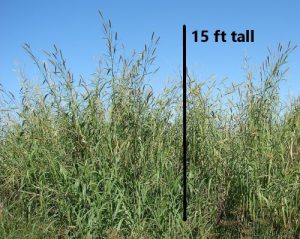CANE GRASS, ELEPHANT GRASS, NAPIER GRASS (Cenchrus purpureus)
 Hawai‘i-Pacific Weed Risk Assessment Score: 16 (High Risk). Visit Plant Pono for more information.
Hawai‘i-Pacific Weed Risk Assessment Score: 16 (High Risk). Visit Plant Pono for more information.
Weed Fire Risk Score = 0.72 (This species is likely a high fire risk in Hawai’i); Visit Pacific Fire Exchange Weed Risk Assessments for more information
Regulatory Status: None
Prevention and Control Category: N/A
Description
- Cane grass is a large perennial grass with erect stems that grow to 15 feet tall.
- It is stout and forms large tussocks, with short and creeping rhizomes. The grass stems (culms) rise in an ascending fashion and root at the base. Stems are frequently branched above and range in height from 2 to 4 meters. The leaf sheaths are mostly smooth and without hairs, while the leaf blades are linear and flat, reaching up to 120 centimeters in length and 3 centimeters in width. The ligule is quite short, only 1.5 to 5 millimeters in length, but is densely covered with hairs. The inflorescences (flowers) take the form of dense panicles (branched, tree-like arrangement of flowers or flower clusters) that are golden, brownish, or purplish in color, measuring 10 to 30 centimeters long and 1 to 3 centimeters wide. The spikelets, or small bundle or cluster of flowers that make up the larger, feathery plume, are about 4 to 6 millimeters long, and can appear singly or in clusters of two to six, each surrounded by bristles that are 20 millimeters long or even longer. Typically, the lower glume is missing, and the upper glume is only one-quarter to one-half the length of the spikelet.
- Cane grass is native to tropical Africa, but is cultivated in many places and escaping cultivation elsewhere. In Malesia, a biogeographical region in Southeast Asia, this grass widely grown and found naturalized outside of cultivation.
Impacts
- Forms dense stands and excludes other vegetation.
- Prevents regeneration of other plant species.
- Reproduces rapidly by vegetative growth from rhizomes; even small pieces of rhizome can resprout.
- Recovers well following fire and can dominate fire-adapted savannah communities
- May increase fire risk during periods of drought, but seldom dry enough to burn under normal circumstances.
Uses
- An important forage grass, with a number of cultivars and hybrids available.
- May serve as a fire break in managed landscapes.
Distribution
Naturalized in fields, pastures, and along roadsides, especially in mesic to wet sites, 10-1,220 m, on Kauaʻi, Oʻahu, Molokaʻi, Lanaʻi, Maui, Kahoʻolawe, and Hawaiʻi.
